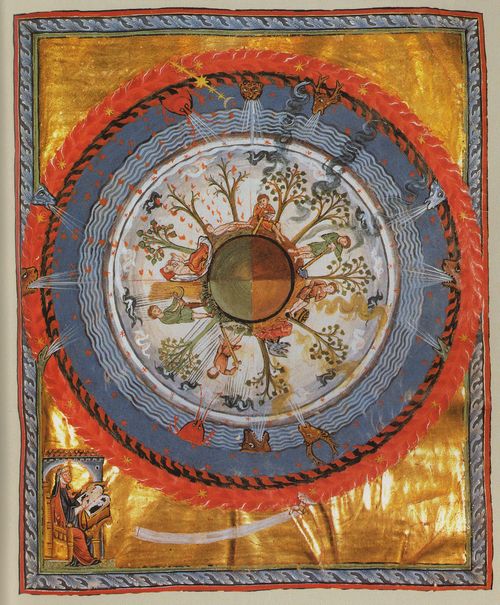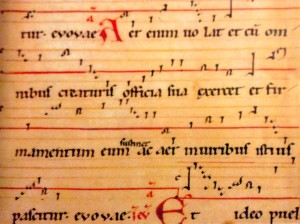Hildegard of Bingen
Hildegard of Bingen (1098 – 1179) was born as tenth child into a German noble family. As was not uncommon in the Middle Ages, her parents promised her, as the tenth chid, to the church. At the age of eight she was entrusted to the Benedictine Monastery of Disibodenberg, where a young woman, Jutta von Spanheim, with her followers lived a cloistered life in a room added to the monastery. Hildegard took the veil at age fifteen. In the Middle Ages,entering a monastery was often the only way a girl could be educated and allowed to follow any aspirations in science and the arts.
In 1136, when Jutta died, Hildegard took over as superior. Around 1150 she founded her own monastery on the Ruperts berg, in the Rhine Valley, over the protests of the abbot at Disibodenberg. By this time she had become quite famous, which is why she succeeded. She also founded a daughter house ( a smaller convent related to and financially dependent on the main monastery ) in Eibingen on the opposite bank of the Rhine.
Hildegard’s visions and her works
Even as a young girl Hildegard had visions. She described how, when she was in her early forties, she fell ill. She saw a great light and heard God’s voice telling her to write
down what she saw in her visions. With the help of her secretary, Volmar, she recorded all of them. She also wrote down the poems she heard in her visions. Some of them included music. Besides the records of her visions she also wrote many books on theology and treatises on the medicinal qualities of minerals. herbs, vegetables and grains.
( Her writings are still studied in German universities as part of the history of medicine, and you can find practitioners at hospitals who use Hildegard’s healing methods to this day). She was also involved in politics and is said to have written letters to the Emperor, Frederick Barbarossa, the pope and numerous bishops, abbots, abbesses and noblemen, telling them her opinions of their actions. People came from all over to hear her sermons, and she herself undertook four extended missions during which she traveled all over Germany.
Hildegard’s importance as a woman composer
In a time when art was created and performed in the service of the church, and when rule of humility required anonymity on the part of the creators, it is remarkable to find a woman writing and composing poems and music under her own name. She claimed to have had no formal training in
music, and she denied being able to read or write music. It is likely that her secretary, Volmar, or one of the nuns in her convent wrote the music down. Whether she dictated the music, or only described it in general terms, and let them do the actual composing, we will never know.
1)Her style is unique in its use of modes (the medieval equivalent of keys). She often combines more than one mode in one piece, something rarely done by her male counterparts.
2)Another quality that sets her music apart is the wide range of her songs. many of them use more than an octave and a half, a range larger than most untrained voices can very comfortably sing.
3)Her music is also very formulaic. She often uses a characteristic opening figure of a fifth and an octave.
– Margriet Tindemans –

